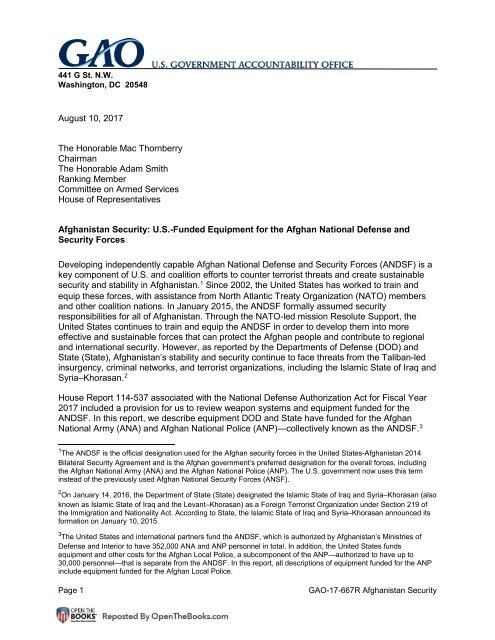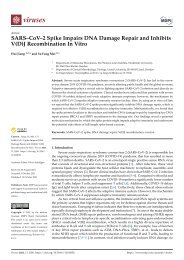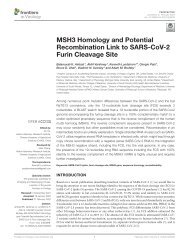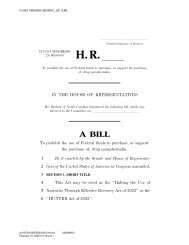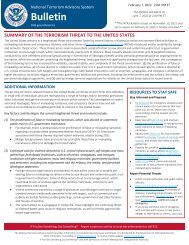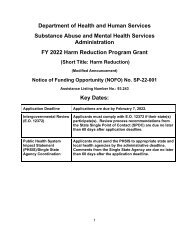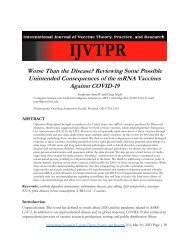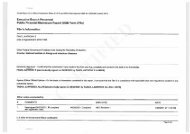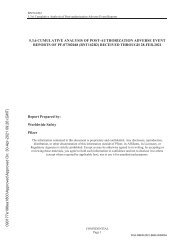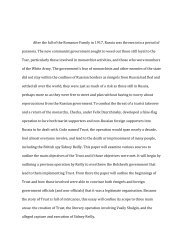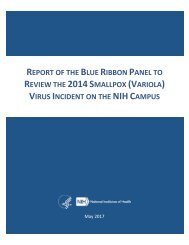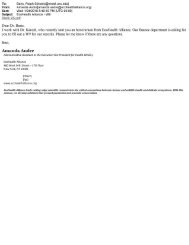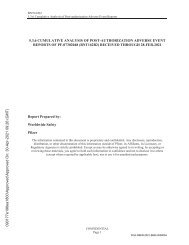GAO Report: Afghanistan Equipment
Create successful ePaper yourself
Turn your PDF publications into a flip-book with our unique Google optimized e-Paper software.
441 G St. N.W.<br />
Washington, DC 20548<br />
August 10, 2017<br />
The Honorable Mac Thornberry<br />
Chairman<br />
The Honorable Adam Smith<br />
Ranking Member<br />
Committee on Armed Services<br />
House of Representatives<br />
<strong>Afghanistan</strong> Security: U.S.-Funded <strong>Equipment</strong> for the Afghan National Defense and<br />
Security Forces<br />
Developing independently capable Afghan National Defense and Security Forces (ANDSF) is a<br />
key component of U.S. and coalition efforts to counter terrorist threats and create sustainable<br />
security and stability in <strong>Afghanistan</strong>. 1 Since 2002, the United States has worked to train and<br />
equip these forces, with assistance from North Atlantic Treaty Organization (NATO) members<br />
and other coalition nations. In January 2015, the ANDSF formally assumed security<br />
responsibilities for all of <strong>Afghanistan</strong>. Through the NATO-led mission Resolute Support, the<br />
United States continues to train and equip the ANDSF in order to develop them into more<br />
effective and sustainable forces that can protect the Afghan people and contribute to regional<br />
and international security. However, as reported by the Departments of Defense (DOD) and<br />
State (State), <strong>Afghanistan</strong>’s stability and security continue to face threats from the Taliban-led<br />
insurgency, criminal networks, and terrorist organizations, including the Islamic State of Iraq and<br />
Syria–Khorasan. 2<br />
House <strong>Report</strong> 114-537 associated with the National Defense Authorization Act for Fiscal Year<br />
2017 included a provision for us to review weapon systems and equipment funded for the<br />
ANDSF. In this report, we describe equipment DOD and State have funded for the Afghan<br />
National Army (ANA) and Afghan National Police (ANP)—collectively known as the ANDSF. 3<br />
1 The ANDSF is the official designation used for the Afghan security forces in the United States-<strong>Afghanistan</strong> 2014<br />
Bilateral Security Agreement and is the Afghan government’s preferred designation for the overall forces, including<br />
the Afghan National Army (ANA) and the Afghan National Police (ANP). The U.S. government now uses this term<br />
instead of the previously used Afghan National Security Forces (ANSF).<br />
2 On January 14, 2016, the Department of State (State) designated the Islamic State of Iraq and Syria–Khorasan (also<br />
known as Islamic State of Iraq and the Levant–Khorasan) as a Foreign Terrorist Organization under Section 219 of<br />
the Immigration and Nationality Act. According to State, the Islamic State of Iraq and Syria–Khorasan announced its<br />
formation on January 10, 2015.<br />
3 The United States and international partners fund the ANDSF, which is authorized by <strong>Afghanistan</strong>’s Ministries of<br />
Defense and Interior to have 352,000 ANA and ANP personnel in total. In addition, the United States funds<br />
equipment and other costs for the Afghan Local Police, a subcomponent of the ANP—authorized to have up to<br />
30,000 personnel—that is separate from the ANDSF. In this report, all descriptions of equipment funded for the ANP<br />
include equipment funded for the Afghan Local Police.<br />
Page 1<br />
<strong>GAO</strong>-17-667R <strong>Afghanistan</strong> Security
Enclosures I-VI provide detailed information on communications equipment; vehicles; weapons;<br />
explosive ordnance disposal (EOD) equipment; intelligence, surveillance, and reconnaissance<br />
(ISR) equipment; and aircraft.<br />
To perform our work, we reviewed security agreements, key legislation, and DOD and State<br />
information related to U.S. efforts to equip the ANDSF, including funding data, manuals<br />
addressing the procurement process, and other DOD documents—specifically, regular reports<br />
DOD submits to Congress on progress toward security and stability in <strong>Afghanistan</strong>. 4 We<br />
analyzed DOD and State data on key equipment, which we define in this report as U.S.-funded<br />
weapons and equipment that DOD considers critical to the missions of the ANDSF. 5 Data on<br />
equipment quantities throughout the report refer to key U.S.-funded equipment and do not<br />
represent an inventory of all equipment funded for the ANDSF. We selected key equipment and<br />
categorized it using information collected from DOD and industry documents and by<br />
interviewing officials in the Office of the Secretary of Defense for Policy, the Defense Security<br />
Cooperation Agency, DOD implementing agencies, and State who were knowledgeable about<br />
the equipping of the ANDSF. The key equipment we describe was authorized for procurement<br />
or transfer through the Defense Security Cooperation Agency for the ANA, ANP, and Afghan<br />
Local Police. We did not include items such as small vehicles and trailers, medical supplies,<br />
spare parts, small arms ammunition, or training manuals.<br />
We report key equipment data based on the fiscal years when DOD authorized the equipment<br />
for procurement or transfer. We did not assess the extent to which key equipment has been<br />
distributed to the ANDSF or is in use. 6 We took steps to test the completeness and accuracy of<br />
the equipment data by comparing them with data in Afghan documents outlining ANDSF<br />
equipment requirements and DOD progress reports, and with other DOD data, as well as by<br />
interviewing DOD officials. We found the data sufficiently reliable for the purposes of describing<br />
and categorizing key U.S.-funded equipment for the ANDSF. To provide background information<br />
on overall funding and disbursements related to equipment for the ANDSF, we analyzed DOD<br />
Comptroller and Special Inspector General for <strong>Afghanistan</strong> Reconstruction data. We took steps<br />
to test the completeness and accuracy of the funding data, such as by discussing them with<br />
relevant officials, and found the data sufficiently reliable for our purposes.<br />
We conducted this performance audit from August 2016 to August 2017 in accordance with<br />
generally accepted government auditing standards. Those standards require that we plan and<br />
perform the audit to obtain sufficient, appropriate evidence to provide a reasonable basis for our<br />
findings and conclusions based on our audit objectives. We believe that the evidence obtained<br />
provides a reasonable basis for our findings and conclusions based on our audit objectives.<br />
4 In the National Defense Authorization Act for Fiscal Year 2008, Pub. L. No. 110-181, § 1230, as amended, Congress<br />
mandated that the President, acting through the Secretary of Defense, submit reports to Congress on progress<br />
toward security and stability in <strong>Afghanistan</strong>, including a comprehensive and long-term strategy and budget for<br />
strengthening the Afghan National Security Forces, through 2014. In the National Defense Authorization Act for Fiscal<br />
Year 2015, Pub. L. No. 113-291, § 1225, Congress mandated that the Secretary of Defense, in consultation with the<br />
Secretary of State, submit a report on building and sustaining the Afghan National Security Forces and enhancing<br />
security and stability in <strong>Afghanistan</strong>, on a semiannual basis through December 2017.<br />
5 All equipment described in encs. I-VI is fully U.S. funded, with the exception of communications equipment in fiscal<br />
years 2003 and 2004, which includes some items funded by a combination of U.S. funds and international donations.<br />
See enc. I for additional details.<br />
6 To determine the fiscal year when DOD authorized the equipment for procurement or transfer, we used DOD data<br />
indicating the date a letter of offer and acceptance was signed to authorize procurement to begin, or, for instances<br />
involving the transfer of equipment provided from preexisting stock, the date equipment transfer was authorized.<br />
Page 2<br />
<strong>GAO</strong>-17-667R <strong>Afghanistan</strong> Security
Background<br />
Following the September 11, 2001, attacks, the United States and several allies invaded<br />
<strong>Afghanistan</strong> to remove the Taliban regime from power for providing a safe haven to the al<br />
Qaeda terrorist group that plotted and conducted the attacks. Since the invasion, the United<br />
States has expressed its support for a sovereign <strong>Afghanistan</strong>, in part through its efforts,<br />
alongside NATO-led coalition forces, to develop <strong>Afghanistan</strong>’s military and police. As Afghan<br />
forces assumed full security responsibilities for the country—a process completed in January<br />
2015—U.S. and NATO forces in <strong>Afghanistan</strong> shifted their role from carrying out combat<br />
operations to training, advising, and assisting their Afghan counterparts. Since that time, the<br />
United States has continued to provide assistance, including key equipment needed by the<br />
ANDSF to accomplish its missions.<br />
Since fiscal year 2002, more than $76 billion has been appropriated or allocated for various<br />
DOD and State programs to support Afghan security, according to the Special Inspector<br />
General for <strong>Afghanistan</strong> Reconstruction. 7 The authorities DOD and State used to fund the key<br />
equipment we describe in this report include authorities for procuring equipment and authorities<br />
for transferring equipment previously purchased for other purposes. Specifically, authorities<br />
used for key equipment include the <strong>Afghanistan</strong> Security Forces Fund (ASFF), <strong>Afghanistan</strong><br />
Freedom Support Act, DOD Counternarcotics, Excess Defense Articles, Foreign Military<br />
Financing, International Narcotics Control and Law Enforcement, and Train and Equip. 8<br />
According to DOD data, about $66 billion of the $76 billion (86 percent) in appropriated funds to<br />
support Afghan security was provided through ASFF, which has also funded most of the key<br />
equipment for the ANDSF. 9<br />
As of April 2017, about $61 billion of the $66 billion in ASFF allocations made since the fund<br />
was established in fiscal year 2005 has been disbursed, according to DOD data. The largest<br />
expenditure of the $61 billion was for sustainment, totaling 44 percent (over $26 billion) of all<br />
ASFF disbursements over this time period. 10 <strong>Equipment</strong> and transportation represented the<br />
second-largest expenditure of the $61 billion, accounting for almost $18 billion, or 29 percent. 11<br />
7 We calculated this sum using data reported by the Special Inspector General for <strong>Afghanistan</strong> Reconstruction on<br />
April 30, 2017.<br />
8 While ASFF, DOD Counternarcotics, Foreign Military Financing, International Narcotics Control and Law<br />
Enforcement, and Train and Equip are used to procure equipment, the <strong>Afghanistan</strong> Freedom Support Act and Excess<br />
Defense Articles permit the transfer of equipment. The <strong>Afghanistan</strong> Freedom Support Act permitted DOD to provide<br />
equipment by drawing down defense articles and services from its stocks or by acquiring them by contract (see the<br />
<strong>Afghanistan</strong> Freedom Support Act of 2002, Pub. L. No. 107-327, 116 Stat. 2797, as amended). The Excess Defense<br />
Articles authority permits DOD to transfer, either on a grant basis or through the Foreign Military Sales program,<br />
defense articles that are determined to be no longer needed by the U.S. government (see 22 U.S.C. § 2321j). Train<br />
and Equip refers to authority granted by Congress in the Department of Defense Appropriations Act, 2005, that<br />
allowed the Secretary of Defense, with the concurrence of the Secretary of State, to use operations and maintenance<br />
funds to train, equip, and provide related assistance to the New Iraqi Army and the Afghan National Army. See Pub.<br />
L. No. 108-287, § 9006.<br />
9 Congress appropriated funds to the ASFF starting in fiscal year 2005 (see Pub. L. No. 109-13, 119 Stat. 231).<br />
10 Sustainment includes salaries, ammunition (including the air-to-ground munitions discussed in enc. VI), equipment<br />
maintenance, information technology, and clothing.<br />
11 According to a DOD Comptroller official, disbursements for transportation were for costs related to transporting<br />
equipment and for contracted pilots and airplanes for transporting officials to meetings. Other activities funded with<br />
Page 3<br />
<strong>GAO</strong>-17-667R <strong>Afghanistan</strong> Security
Figure 1 shows annual ASFF disbursements for equipment and transportation since fiscal year<br />
2005. Of the nearly $18 billion in equipment and transportation disbursements since fiscal year<br />
2005, about $13 billion was for the ANA, and about $4.5 billion was for the ANP.<br />
Figure 1: <strong>Afghanistan</strong> Security Forces Fund Disbursements for <strong>Equipment</strong> and Transportation, by Fiscal<br />
Year of Appropriation, 2005–2016<br />
The United States Has Funded a Variety of Key <strong>Equipment</strong> for the ANDSF Since 2003<br />
In 2003, the United States began funding a variety of key equipment for the ANDSF. Figure 2<br />
shows total quantities of equipment the United States funded for the ANDSF in fiscal years 2003<br />
through 2016. 12<br />
ASFF include infrastructure (nearly $9 billion), training and operations (almost $8 billion), and related activities<br />
(almost $400 million).<br />
12 Data on equipment quantities throughout the report refer to key U.S.-funded equipment and do not represent an<br />
inventory of all equipment funded for the ANDSF. The overall equipment quantities in fig. 2 do not include the<br />
biometrics and positioning system equipment or air-to-ground munitions described in encs. V and VI, respectively.<br />
Page 4<br />
<strong>GAO</strong>-17-667R <strong>Afghanistan</strong> Security
Figure 2: Total Quantity of Key U.S.-Funded <strong>Equipment</strong> for the Afghan National Defense and Security Forces,<br />
by Fiscal Year, 2003–2016<br />
Notes: Figure shows data broken out by the fiscal years in which DOD authorized the equipment for procurement or<br />
for transfer.<br />
The data include equipment funded for the Afghan Local Police, a subcomponent of the Afghan National Police that,<br />
though separate from the <strong>Afghanistan</strong> National Defense and Security Forces, has received U.S.-funded equipment.<br />
Six categories of key equipment are included in the total quantities shown in this figure: communications equipment;<br />
vehicles; weapons; explosive ordnance disposal equipment; intelligence, surveillance, and reconnaissance<br />
equipment; and aircraft. The amount of each category of equipment authorized each year varied over time.<br />
Our analysis of DOD data identified six categories of key equipment that the United States<br />
funded for the ANDSF from fiscal years 2003 through 2016 (see table 1).<br />
Page 5<br />
<strong>GAO</strong>-17-667R <strong>Afghanistan</strong> Security
Table 1: Quantities of Key U.S.-Funded <strong>Equipment</strong> for the Afghan National Defense and Security Forces, by<br />
Type and Fiscal Year, 2003–2016<br />
Fiscal<br />
year<br />
Communications<br />
equipment Vehicles Weapons<br />
Explosive<br />
ordnance<br />
disposal<br />
equipment<br />
Intelligence,<br />
surveillance,<br />
and<br />
reconnaissance<br />
equipment Aircraft Total<br />
2003 497 510 0 0 0 0 1,007<br />
2004 1,528 11 10,700 0 0 0 12,239<br />
2005 9,340 2,503 28,913 0 0 0 40,756<br />
2006 21,563 9,251 133,964 57 0 0 164,835<br />
2007 3,743 2,292 126,878 81 1,205 1 134,200<br />
2008 14,720 15,619 46,431 0 0 31 76,801<br />
2009 21,704 7,521 59,976 468 792 7 90,468<br />
2010 22,525 8,902 20,276 195 5,072 2 56,972<br />
2011 47,928 21,841 27,207 2,582 3,643 59 103,260<br />
2012 1,825 0 20 1,399 0 50 3,294<br />
2013 6,578 139 21,114 22,383 4,992 32 55,238<br />
2014 1,361 0 143 365 254 13 2,136<br />
2015 4,237 5,512 43,994 1,640 233 10 55,626<br />
2016 5,094 1,797 80,074 511 0 3 87,479<br />
Total 162,643 75,898 599,690 29,681 16,191 208 884,311<br />
Source: <strong>GAO</strong> analysis of Department of Defense (DOD) data. | <strong>GAO</strong>-17-667R<br />
Note: Data are broken out by the fiscal years in which DOD authorized the equipment for procurement or for transfer.<br />
Communications equipment and vehicles were first authorized for procurement in fiscal year 2003; weapons in 2004;<br />
explosive ordnance disposal equipment in 2006; and intelligence, surveillance, and reconnaissance (ISR) equipment<br />
and aircraft in 2007. ISR equipment funded from fiscal year 2007 until fiscal year 2013 consisted of night vision<br />
devices, while other types of ISR equipment were funded in subsequent years.<br />
As we have previously reported, it can take several years between the date DOD authorizes<br />
equipment for procurement and the date when the equipment is delivered to <strong>Afghanistan</strong>, and a<br />
number of additional months may pass before the ANDSF is ready to use the equipment. 13 For<br />
example, DOD authorized the procurement of 20 light attack airplanes in fiscal year 2012 and,<br />
according to DOD documentation, the first of those aircraft were delivered to <strong>Afghanistan</strong> in<br />
2016. As of March 2017, about 5 years after DOD authorized the procurement of the airplanes,<br />
DOD reported that the Afghan Air Force was using 12 of the airplanes in operations and that<br />
another 7 were being used for training at Moody Air Force Base in the United States. 14 The<br />
need to first train personnel in equipment use can also influence equipment delivery time<br />
frames. For example, DOD also authorized the procurement of ISR equipment—8 ScanEagle<br />
unmanned air systems—in September 2015. According to DOD officials, DOD plans to deliver<br />
13 We have previously reported that the time between the date when equipment procurement begins and the date the<br />
equipment is ready to ship is often the longest phase of the security assistance process, lasting from about 40 days<br />
to almost 3 years in some cases, as of fiscal year 2011. However, DOD officials reported this process can be faster<br />
for programs such as ASFF that are intended to build partner capacity. See <strong>GAO</strong>, Security Assistance: DOD’s<br />
Ongoing Reforms Address Some Challenges, but Additional Information Is Needed to Further Enhance Program<br />
Management, <strong>GAO</strong>-13-84 (Washington, D.C.: Nov. 16, 2012).<br />
14 The 20th light attack airplane was lost in a crash during training, according to DOD documentation.<br />
Page 6<br />
<strong>GAO</strong>-17-667R <strong>Afghanistan</strong> Security
all of that equipment to <strong>Afghanistan</strong> by the end of 2017, if training of ANDSF personnel who will<br />
operate the unmanned air systems is completed on schedule.<br />
Once key equipment arrives in <strong>Afghanistan</strong>, it is distributed to either the ANA or the ANP. Figure<br />
3 outlines the distribution of this equipment between the ANA and the ANP as planned when the<br />
equipment was authorized for procurement. 15<br />
Figure 3: Quantity of Key U.S.-Funded <strong>Equipment</strong> for the Afghan National Defense and Security Forces, by<br />
Type and Recipient Force, Fiscal Years 2003–2016<br />
Notes: The time frame covered by this figure refers to the fiscal years in which DOD authorized the equipment for<br />
procurement or for transfer.<br />
The data include equipment funded for the Afghan Local Police, a subcomponent of the Afghan National Police that,<br />
though separate from the <strong>Afghanistan</strong> National Defense and Security Forces, has received U.S.-funded equipment.<br />
While weapons and communications represent the largest quantity of key equipment DOD<br />
authorized for procurement, vehicles and aircraft represent 65 percent of the cost of all<br />
equipment transferred to the ANDSF, according to the Special Inspector General for<br />
<strong>Afghanistan</strong> Reconstruction. 16 The enclosures provide more details about the quantities and<br />
types of equipment authorized for procurement, as follows:<br />
15 In addition to the key equipment described in these figures, DOD and State also funded key equipment for the<br />
ANDSF’s lead component for counternarcotics efforts, the Counter Narcotics Police of <strong>Afghanistan</strong> (CNPA).<br />
Specifically, according to State, using International Narcotics Control and Law Enforcement funding, State authorized<br />
the transfer of communications equipment to the CNPA. Using DOD Counternarcotics funding, DOD authorized the<br />
procurement of key equipment for the CNPA, including communications equipment, according to DOD. Unlike the key<br />
equipment for the other ANDSF components, this equipment was procured outside of the Defense Security<br />
Cooperation Agency’s procurement process and therefore is not included in our data.<br />
16 See the Special Inspector General for <strong>Afghanistan</strong> Reconstruction, Quarterly <strong>Report</strong> to Congress (Arlington, VA.:<br />
Apr. 30, 2017).<br />
Page 7<br />
<strong>GAO</strong>-17-667R <strong>Afghanistan</strong> Security
Enclosure I: Communications equipment<br />
Enclosure II: Vehicles<br />
Enclosure III: Weapons<br />
Enclosure IV: EOD equipment<br />
Enclosure V: ISR equipment (including biometrics and positioning system equipment)<br />
Enclosure VI: Aircraft (including air-to-ground munitions)<br />
Agency Comments<br />
We provided a draft of this report to DOD and State for their review. DOD provided technical<br />
comments, which we incorporated as appropriate. State had no comments.<br />
- - -<br />
We are sending copies of this report to the appropriate congressional committees, the Secretary<br />
of Defense, and the Secretary of State. In addition, the report will be available at no charge on<br />
the <strong>GAO</strong> website at http://www.gao.gov.<br />
If you or your staff have any questions about this report, please contact me at (202) 512-6991 or<br />
FarbJ@gao.gov. Contact points for our Offices of Congressional Relations and Public Affairs<br />
may be found on the last page of this report. <strong>GAO</strong> staff who made key contributions to this<br />
report are Joyee Dasgupta (Assistant Director), Katherine Forsyth (Analyst-in-Charge), Parke<br />
Nicholson, and Bridgette Savino. The team also benefited from the expert advice and<br />
assistance of David Dayton, Neil Doherty, Carl Barden, Justin Fisher, Ashley Alley, Mark<br />
Dowling, Cary Russell, and James Reynolds.<br />
Jessica Farb<br />
Director, International Affairs and Trade<br />
Enclosures – 6<br />
Page 8<br />
<strong>GAO</strong>-17-667R <strong>Afghanistan</strong> Security
Enclosure I<br />
Key U.S.-Funded Communications <strong>Equipment</strong> for the Afghan National Defense and<br />
Security Forces (ANDSF)<br />
According to Department of Defense (DOD) data, the United States funded about 163,000 key<br />
communications equipment items for the ANDSF in fiscal years 2003 through 2016 (see table<br />
2).<br />
• The majority of the key communications equipment was tactical radios, which include the<br />
high frequency, very high frequency, ultra high frequency, super high frequency, and<br />
multiband radios.<br />
• About 88 percent of all the key communications equipment items were authorized for<br />
procurement by DOD in fiscal years 2003 through 2011.<br />
• About 97 percent of the radios included in DOD’s data were manufactured by Harris,<br />
Datron, Motorola, or Codan.<br />
Table 2: Quantities and Examples of Key U.S.-Funded Communications <strong>Equipment</strong> for the Afghan National<br />
Defense and Security Forces, Fiscal Years 2003–2016<br />
Category Quantity Examples<br />
Very high frequency radios 75,256 Datron PRC-1070 handheld, Datron PRC-1077<br />
vehicle-mounted, Datron HH7700 handheld<br />
Nontactical radios 66,439 Motorola GM360, Codan NGT SRx, Universal<br />
Radio AR-8200 Mark III<br />
High frequency radios 13,464 Codan 2110 manpack, Datron RT-7000 base<br />
station<br />
Multiband radios 5,377 Harris RF-5800M base station, Harris RF-7850M<br />
vehicle-mounted<br />
Ultra and super high frequency radios 2,107 Harris RF-7800W vehicle-mounted, EF Johnson<br />
APCO-25 handheld<br />
Total 162,643<br />
Source: <strong>GAO</strong> analysis of Department of Defense (DOD) data. | <strong>GAO</strong>-17-667R<br />
Notes: The time frame covered by this table refers to the fiscal years in which DOD authorized the equipment for<br />
procurement.<br />
Included in the table are 497 high frequency radios and 1,528 very high frequency radios that were authorized in<br />
fiscal years 2003 and 2004 using a combination of Foreign Military Financing and international donations, according<br />
to DOD data. Those data did not indicate how many of those radios were funded by international donations. The<br />
remaining equipment in this category and the other categories was reported as being funded using only U.S. funds.<br />
High frequency radios operate in the 3–30 megahertz frequency range, very high frequency radios operate in the 30–<br />
300 megahertz range, ultra high frequency radios operate in the 300–3,000 megahertz range, and super high<br />
frequency radios operate in the 3,000–30,000 megahertz range. Multiband radios can operate across more than one<br />
of these frequency bands. The nontactical radios category includes commercially available handheld radios that are<br />
not designed for use in combat.<br />
According to DOD data, about 94,900 of the U.S.-funded communications equipment items<br />
were for the Afghan National Army (ANA), and the remaining approximately 67,700 items were<br />
for the Afghan National Police (ANP) in fiscal years 2003 through 2016 (see fig. 4).<br />
• DOD data show that the ANA received 96 percent of the tactical radios and that the ANP<br />
received 95 percent of the nontactical radios.<br />
Page 9<br />
<strong>GAO</strong>-17-667R <strong>Afghanistan</strong> Security
• According to a DOD communications equipment manual, the primary advantage of using<br />
high frequency radios is their capability to provide long-range, over-the-horizon<br />
communication. However, high frequency radios’ long-range capability makes their<br />
communications susceptible to enemy interception.<br />
• Very high frequency and ultra high frequency radios are normally limited to line-of-sight<br />
communication, so their range is restricted, according to a DOD equipment manual. Very<br />
high frequency radios are generally used in the military by combat and combat support<br />
units while on the move. Ultra high frequency radios are generally used in the military for<br />
ground-to-air communication. Super high frequency radios are used for radar<br />
surveillance and satellite communications.<br />
Figure 4: Quantity of Key U.S.-Funded Communications <strong>Equipment</strong> for the Afghan National Defense and<br />
Security Forces, by Recipient Force, Fiscal Years 2003–2016<br />
Notes: The time frame covered by this figure refers to the fiscal years in which DOD authorized the equipment for<br />
procurement.<br />
Included in the table are 497 high frequency radios and 1,528 very high frequency radios that were authorized in<br />
fiscal years 2003 and 2004 using a combination of Foreign Military Financing and international donations, according<br />
to DOD data. Those data did not indicate how many of those radios were funded by international donations. The<br />
remaining equipment in this category and the other categories was reported as being funded using only U.S. funds.<br />
High frequency radios operate in the 3–30 megahertz frequency range, very high frequency radios operate in the 30–<br />
300 megahertz range, ultra high frequency radios operate in the 300–3,000 megahertz range, and super high<br />
frequency radios operate in the 3,000–30,000 megahertz range. Multiband radios can operate across more than one<br />
of these frequency bands. The nontactical radios category includes commercially available handheld radios that are<br />
not designed for use in combat.<br />
Page 10<br />
<strong>GAO</strong>-17-667R <strong>Afghanistan</strong> Security
Enclosure II<br />
Key U.S.-Funded Vehicles for the Afghan National Defense and Security Forces (ANDSF)<br />
According to Department of Defense (DOD) data, the United States funded about 76,000 key<br />
vehicles for the ANDSF in fiscal years 2003 through 2016 (see fig. 5).<br />
• Over half of the U.S.-funded vehicles are light tactical vehicles, including pickup trucks.<br />
• While nearly 30 percent of the vehicles are Humvees, almost half of those are<br />
ambulance, cargo, and troop enclosure variants. The other half of the Humvees are guntruck<br />
variants.<br />
• Recovery vehicles include wrecker trucks and Mine Resistant Ambush Protected<br />
(MRAP) recovery vehicles that use a large crane to recover disabled vehicles.<br />
• MRAP vehicles, which are designed to mitigate the effects of improvised explosive<br />
devices, represent less than 2 percent of the vehicles in the DOD data.<br />
Figure 5: Quantities and Examples of Key U.S.-Funded Vehicles for the Afghan National Defense and<br />
Security Forces, Fiscal Years 2003–2016<br />
Note: The time frame covered by this figure refers to the fiscal years in which DOD authorized the equipment for<br />
procurement or for transfer.<br />
According to DOD data, the United States funded about 40,000 key vehicles for the Afghan<br />
National Army (ANA) and about 36,000 for the Afghan National Police (ANP) in fiscal years<br />
2003 through 2016 (see fig. 6).<br />
• According to DOD data, over 40 percent of the vehicles funded for the ANA and more<br />
than 70 percent of the vehicles funded for the ANP are light tactical vehicles, which lack<br />
armor, according to DOD documentation. However, DOD has not authorized any light<br />
tactical vehicles since fiscal year 2011, according to DOD data.<br />
Page 11<br />
<strong>GAO</strong>-17-667R <strong>Afghanistan</strong> Security
• DOD documents state that ANA and ANP components are frequently in combat with<br />
insurgents; as a result, both have been equipped in part with armored Humvees, which,<br />
unlike light tactical vehicles, can withstand small arms fire. DOD data show that DOD<br />
authorized the procurement of over 2,000 Humvees for the ANA and more than 2,600 for<br />
the ANP in fiscal years 2015 and 2016. According to DOD officials, as of June 2017,<br />
DOD plans to procure another 2,000 new Humvees and refurbish and transfer an<br />
additional 1,600 Humvees for the ANDSF over the next 2 fiscal years. However, the<br />
officials noted that many of the Humvees provided to the ANDSF do not offer the same<br />
levels of protection as those given to U.S. forces. In recognition of this and other factors,<br />
DOD plans to conduct a study that will include an assessment of optimal types of<br />
vehicles for ANDSF units, depending on their function and mission, according to DOD<br />
officials.<br />
Figure 6: Quantity of Key U.S.-Funded Vehicles for the Afghan National Defense and Security Forces, by<br />
Type and Recipient Force, Fiscal Years 2003–2016<br />
Note: The time frame covered by this figure refers to the fiscal years in which DOD authorized the equipment for<br />
procurement or for transfer.<br />
Page 12<br />
<strong>GAO</strong>-17-667R <strong>Afghanistan</strong> Security
Enclosure III<br />
Key U.S.-Funded Weapons for the Afghan National Defense and Security Forces (ANDSF)<br />
According to Department of Defense (DOD) data, the United States funded almost 600,000 key<br />
weapons for the ANDSF in fiscal years 2004 through 2016 (see fig. 7).<br />
• Of these 600,000 weapons, almost 81 percent were rifles and pistols.<br />
• The United States has funded both North Atlantic Treaty Organization (NATO) standard<br />
and non–NATO standard weapons. 17 According to DOD documentation, NATO standard<br />
weapons, such as M16 rifles, M4 carbines, and M203 grenade launchers, became basic<br />
issue for the Afghan National Army (ANA) in 2010. As of May 2017, the Afghan National<br />
Police (ANP) were continuing to transition from some non–NATO standard weapons,<br />
such as AK-47 rifles, to NATO standard weapons, according to DOD officials.<br />
• According to DOD documentation, indirect fire weapons, such as the D-30 howitzers and<br />
mortars, are significant enablers for the ANDSF. 18 For example, ANA forces are<br />
improving their ability to use these items in combat operations, which lessens some of<br />
their reliance on aerial fire support from the Afghan Air Force.<br />
17 NATO standard refers to the NATO-approved standardization processes applied to equipment, which can include<br />
production codes and equipment specifications. According to the NATO Logistics Handbook, the aim of<br />
standardization is to enhance NATO’s operational effectiveness and to improve the efficient use of available<br />
resources.<br />
18 Indirect fire refers to firing a projectile in the general direction of a target without a direct line of sight between the<br />
weapon and its target.<br />
Page 13<br />
<strong>GAO</strong>-17-667R <strong>Afghanistan</strong> Security
Figure 7: Quantities and Examples of Key U.S.-Funded Weapons for the Afghan National Defense and<br />
Security Forces, Fiscal Years 2004–2016<br />
Note: The time frame covered by this figure refers to the fiscal years in which DOD authorized the equipment for<br />
procurement or for transfer.<br />
a Of the grenade launchers included in the DOD data, 93 percent are underbarrel attachments, such as the GP-25<br />
and M203.<br />
According to DOD data, about 322,000 of the U.S.-funded weapons were for the ANA, and the<br />
remaining 278,000 were for the ANP in fiscal years 2004 through 2016 (see fig. 8).<br />
• Some of the U.S.-funded ANP equipment has included heavy weaponry, such as rocketpropelled<br />
weapons (about 6,500 items total) and small quantities of indirect fire weapons<br />
(36 items total, all of which were mortars). The Afghan Border Police, a component of<br />
the ANP, are responsible for securing and patrolling ports of entry, such as airports and<br />
border-crossing points, and guarding against the illegal entry of persons, weapons,<br />
narcotics, and other goods. According to DOD documentation, Afghan Border Police<br />
stationed along the border are trained and equipped with rifles, light and heavy machine<br />
guns, rocket-propelled grenade launchers, and mortars.<br />
• ANP forces are sometimes on the front lines working to hold areas cleared by the ANA.<br />
For example, DOD documentation describes the Afghan National Civil Order Police—the<br />
ANDSF police unit that requested the most rocket-propelled weapons—as a<br />
counterinsurgency force that helps the ANA secure seized terrain. The long-term goal is<br />
to transition the ANP to a more traditional police role, according to DOD documentation.<br />
Page 14<br />
<strong>GAO</strong>-17-667R <strong>Afghanistan</strong> Security
Figure 8: Quantity of Key U.S.-Funded Weapons for the Afghan National Defense and Security Forces, by<br />
Type and Recipient Force, Fiscal Years 2004–2016<br />
Note: The time frame covered by this figure refers to the fiscal years in which DOD authorized the equipment for<br />
procurement or for transfer.<br />
Page 15<br />
<strong>GAO</strong>-17-667R <strong>Afghanistan</strong> Security
Enclosure IV<br />
Key U.S.-Funded Explosive Ordnance Disposal (EOD) <strong>Equipment</strong> for the Afghan National<br />
Defense and Security Forces (ANDSF)<br />
According to Department of Defense (DOD) data, the United States funded about 30,000 key<br />
EOD equipment items for the ANDSF in fiscal years 2006 through 2016 (see table 3).<br />
• DOD documentation has noted that this equipment is important to the ANDSF’s<br />
capability to counter improvised explosive devices (IED), which pose a significant threat.<br />
For example, according to DOD documents, IEDs were the second-largest source of<br />
effective enemy-initiated attacks in <strong>Afghanistan</strong> from June 2014 to May 2017. 19<br />
• According to DOD documentation, the ANDSF’s capability to counter IEDs, mines, and<br />
other explosive devices and to safely clear routes supports the overall ANDSF strategy<br />
by enhancing ground force mobility and maneuverability. Coalition advisors train and<br />
equip the ANDSF with electronic countermeasure devices, hand-held mine detectors,<br />
bomb detection and disposal robots, bomb suits, mine rollers, and related equipment.<br />
Table 3: Quantities and Examples of Key U.S.-Funded Explosive Ordnance Disposal (EOD) <strong>Equipment</strong> for the<br />
Afghan National Defense and Security Forces, Fiscal Years 2006–2016<br />
Category Quantity Examples<br />
Electronic countermeasure devices 13,265 Symphony jammer, PIPPER<br />
Mine detectors 13,367 VMH3CS, CMD<br />
Bomb detection and disposal robots 1,093 MMP-30 robot<br />
Personal protective equipment 1,101 EOD bomb suit<br />
Mine rollers 496<br />
X-ray systems 359 RTR4-L<br />
Total 29,681<br />
Self-Protection Adaptive<br />
Roller Kit<br />
Source: <strong>GAO</strong> analysis of Department of Defense (DOD) data. | <strong>GAO</strong>-17-667R<br />
Notes: The time frame covered by this table refers to the fiscal years in which DOD authorized the equipment for<br />
procurement or for transfer.<br />
No EOD equipment was authorized in fiscal year 2008.<br />
• Of the nearly 30,000 EOD items DOD funded for the ANDSF, almost 19,000 were for the<br />
ANA, and nearly 11,000 were for the ANP.<br />
• DOD data show that DOD authorized the procurement of more than three-quarters of the<br />
key EOD equipment in fiscal year 2013. A DOD document from that year cited a<br />
significant gap in the ANDSF’s ability to deploy teams to counter IEDs. According to a<br />
DOD official, it was also the last year in which U.S. forces partnered with ANA and ANP<br />
units to train and equip them to independently conduct route clearance operations before<br />
the U.S. combat mission ended in December 2014.<br />
19 DOD has defined effective enemy-initiated attacks as security incidents initiated by the enemy that result in at least<br />
one noninsurgent death or injury.<br />
Page 16<br />
<strong>GAO</strong>-17-667R <strong>Afghanistan</strong> Security
Enclosure V<br />
Key U.S.-Funded Intelligence, Surveillance, and Reconnaissance (ISR) <strong>Equipment</strong> for the<br />
Afghan National Defense and Security Forces (ANDSF)<br />
According to Department of Defense (DOD) data, the United States funded more than 16,000<br />
key ISR equipment items for the ANDSF in fiscal years 2007 through 2016 (see fig. 9).<br />
Figure 9: Quantities and Types of Key U.S.-Funded Intelligence, Surveillance, and Reconnaissance<br />
<strong>Equipment</strong> for the Afghan National Defense and Security Forces, Fiscal Years 2007–2016<br />
Notes: The time frame covered by this figure refers to the fiscal years in which DOD authorized the equipment for<br />
procurement or for transfer.<br />
The equipment listed for any given category in the “Types” column of the figure above constitutes an exhaustive list of<br />
items for that category.<br />
• Night vision devices represent approximately 99 percent of the ISR equipment in the<br />
DOD data. About 10,200 of the night vision devices were for the Afghan National Army<br />
(ANA), and about 5,800 were for the Afghan National Police (ANP). The remaining ISR<br />
items were all for the ANA.<br />
• According to DOD documentation, ISR is an emergent capability for the ANA, which is<br />
still developing the ability to conduct intelligence-driven operations and continues to rely<br />
on contractor support to maintain ISR systems.<br />
• The ScanEagle unmanned air systems carry cameras and are intended to provide timely<br />
and accurate ISR, allowing for intelligence-driven operations at the tactical level,<br />
according to DOD documentation. DOD officials told us that DOD plans to send the<br />
ScanEagles to <strong>Afghanistan</strong> in phases, with the goal of having all eight transferred to the<br />
ANDSF in late 2017.<br />
Page 17<br />
<strong>GAO</strong>-17-667R <strong>Afghanistan</strong> Security
Biometrics and Positioning System <strong>Equipment</strong><br />
The United States has also funded biometrics and positioning equipment for the ANDSF. 20 The<br />
biometrics system included numerous components, such as computers; webcams; and<br />
fingerprint, palm, and iris scanners. The biometrics system is used to store and manage<br />
personal identification information that can be used to vet ANDSF personnel; ensure ANDSF<br />
salary payments are sent to current employees; and support law enforcement, security, and<br />
intelligence operations, according to DOD documentation and officials. 21 DOD funded<br />
biometrics components in fiscal years 2008 through 2016, according to DOD data.<br />
According to DOD data, the United States has also funded the Afghan National Tracking<br />
System, which is composed of various items, including global positioning system equipment.<br />
The system provides location and identification data for purposes such as allowing the Afghan<br />
Air Force and ANA Special Operations Command to track the location of ANDSF forces and<br />
aircraft, in part to reduce friendly fire incidents, according to DOD documentation. According to<br />
DOD data, the system was funded in fiscal years 2011 through 2013 for the ANA and the ANP.<br />
20 According to a DOD official, biometrics and positioning system equipment is challenging to quantify. For example,<br />
the biometrics system called the Afghan Automated Biometrics Information System is made up of many different<br />
components but operates as one system. Thus, we did not include specific quantities for these systems in this report.<br />
21 We have previously reported on the role of biometric information in preventing insider attacks on U.S. and coalition<br />
military personnel in <strong>Afghanistan</strong>. For example, DOD has used its own biometric information system to help screen<br />
ANDSF members before they come into contact with DOD personnel. For more information, see <strong>Afghanistan</strong>: Key<br />
Oversight Issues, <strong>GAO</strong>-13-218SP (Washington, D.C.: Feb. 11, 2013).<br />
Page 18<br />
<strong>GAO</strong>-17-667R <strong>Afghanistan</strong> Security
Enclosure VI<br />
U.S.-Funded Aircraft for the Afghan National Defense and Security Forces (ANDSF)<br />
According to Department of Defense (DOD) data, the United States funded 208 aircraft for the<br />
ANDSF in fiscal years 2007 through 2016; more than half were helicopters, and more than a<br />
quarter were transport/cargo airplanes (see fig. 10). These aircraft were for the Afghan National<br />
Army’s two air components, the Afghan Air Force and the Special Mission Wing. 22<br />
Figure 10: Quantities and Types of U.S.-Funded Aircraft for the Afghan National Defense and Security<br />
Forces, Fiscal Years 2007–2016<br />
Notes: The time frame covered by this figure refers to the fiscal years in which DOD authorized the equipment for<br />
procurement.<br />
The equipment listed for any given category in the “Types” column of the figure above constitutes an exhaustive list of<br />
items for that category.<br />
a The T-182, G-222, and AN-32 airplanes are decommissioned aircraft that are no longer in inventory.<br />
The first aircraft DOD authorized for procurement for the ANDSF was the Mi-17 helicopter in<br />
fiscal year 2007, followed by transport/cargo airplanes in fiscal year 2008. The introduction of<br />
light attack airplanes funded in fiscal year 2012 reflected an aircraft modernization plan DOD<br />
developed in 2010 (see fig. 11). The PC-12 was also funded in fiscal year 2012, primarily to<br />
provide intelligence, surveillance, and reconnaissance support to the Special Mission Wing.<br />
22 The Special Mission Wing provides expeditionary support for counterterrorism and counternarcotics missions,<br />
according to DOD. To date, the United States has not funded any aircraft for the Afghan National Police.<br />
Page 19<br />
<strong>GAO</strong>-17-667R <strong>Afghanistan</strong> Security
Figure 11: Quantity of U.S.-Funded Aircraft for the Afghan National Defense and Security Forces, by Type<br />
and Authorization Year, Fiscal Years 2007–2016<br />
Note: The time frame covered by this figure refers to the fiscal years in which DOD authorized the equipment for<br />
procurement.<br />
DOD plans to use appropriations passed by Congress in May 2017 to fund an aviation transition<br />
program for the Afghan Air Force and Special Mission Wing to address capability gaps identified<br />
by DOD. This program includes plans to procure the UH-60 helicopter to replace the Russianmade<br />
Mi-17. 23 The program would also provide additional armed MD-530 helicopters and A-29<br />
light attack airplanes, while also introducing the AC-208, an armed variant of the C-208<br />
transport/cargo airplane. According to the commander of U.S. Central Command, this program<br />
is needed to improve the effectiveness of the ANDSF, reduce its casualties, and allow it to have<br />
an advantage over the insurgents and terrorists it faces.<br />
Air-to-Ground Munitions<br />
According to DOD data, the United States has funded various air-to-ground munitions for the<br />
Afghan National Army in fiscal years 2007 through 2017. 24 According to DOD documentation,<br />
such munitions provide critical air support to ground forces. These munitions include the<br />
following:<br />
23 According to DOD’s data, the United States has funded 80 Mi-17 helicopters since fiscal year 2007, representing<br />
over a third of all U.S.-funded aircraft for the ANDSF.<br />
24 The air-to-ground munitions described in this report all exceed .50 caliber in diameter.<br />
Page 20<br />
<strong>GAO</strong>-17-667R <strong>Afghanistan</strong> Security
• about 214,00 unguided rockets (e.g., 57mm and 80mm rockets for use on Mi-17<br />
helicopters and Hydra rockets for use on MD-530 helicopters and A-29 light attack<br />
airplanes); 25<br />
• more than 8,700 general-purpose bombs for use with the A-29 light attack airplanes<br />
(e.g., 250-pound MK-81 and 500-pound MK-82 and BLU-111 bombs) and more than<br />
1,000 kits to enhance the accuracy of those bombs (e.g., GBU-12 and GBU-58 guided<br />
bomb kits); and<br />
• 1,815,000 rounds of ammunition for the 23mm Gryazev-Shipunov cannon used on Mi-<br />
17 helicopters.<br />
DOD documentation stated that, as of June 2017, the Afghan Air Force was able to deploy the<br />
general-purpose bombs from the A-29 light attack airplane with high accuracy and would<br />
receive training to deliver guided bombs in the future.<br />
(101668)<br />
25 In addition to the munitions listed here, DOD funded 15,000 unguided rockets for the ANDSF to practice with in<br />
training exercises.<br />
Page 21<br />
<strong>GAO</strong>-17-667R <strong>Afghanistan</strong> Security
This is a work of the U.S. government and is not subject to copyright protection in the<br />
United States. The published product may be reproduced and distributed in its entirety<br />
without further permission from <strong>GAO</strong>. However, because this work may contain<br />
copyrighted images or other material, permission from the copyright holder may be<br />
necessary if you wish to reproduce this material separately.
<strong>GAO</strong>’s Mission<br />
Obtaining Copies of<br />
<strong>GAO</strong> <strong>Report</strong>s and<br />
Testimony<br />
Order by Phone<br />
Connect with <strong>GAO</strong><br />
To <strong>Report</strong> Fraud,<br />
Waste, and Abuse in<br />
Federal Programs<br />
Congressional<br />
Relations<br />
Public Affairs<br />
Strategic Planning and<br />
External Liaison<br />
The Government Accountability Office, the audit, evaluation, and investigative<br />
arm of Congress, exists to support Congress in meeting its constitutional<br />
responsibilities and to help improve the performance and accountability of the<br />
federal government for the American people. <strong>GAO</strong> examines the use of public<br />
funds; evaluates federal programs and policies; and provides analyses,<br />
recommendations, and other assistance to help Congress make informed<br />
oversight, policy, and funding decisions. <strong>GAO</strong>’s commitment to good government<br />
is reflected in its core values of accountability, integrity, and reliability.<br />
The fastest and easiest way to obtain copies of <strong>GAO</strong> documents at no cost is<br />
through <strong>GAO</strong>’s website (http://www.gao.gov). Each weekday afternoon, <strong>GAO</strong><br />
posts on its website newly released reports, testimony, and correspondence. To<br />
have <strong>GAO</strong> e-mail you a list of newly posted products, go to http://www.gao.gov<br />
and select “E-mail Updates.”<br />
The price of each <strong>GAO</strong> publication reflects <strong>GAO</strong>’s actual cost of production and<br />
distribution and depends on the number of pages in the publication and whether<br />
the publication is printed in color or black and white. Pricing and ordering<br />
information is posted on <strong>GAO</strong>’s website, http://www.gao.gov/ordering.htm.<br />
Place orders by calling (202) 512-6000, toll free (866) 801-7077, or<br />
TDD (202) 512-2537.<br />
Orders may be paid for using American Express, Discover Card, MasterCard,<br />
Visa, check, or money order. Call for additional information.<br />
Connect with <strong>GAO</strong> on Facebook, Flickr, Twitter, and YouTube.<br />
Subscribe to our RSS Feeds or E-mail Updates. Listen to our Podcasts.<br />
Visit <strong>GAO</strong> on the web at www.gao.gov.<br />
Contact:<br />
Website: http://www.gao.gov/fraudnet/fraudnet.htm<br />
E-mail: fraudnet@gao.gov<br />
Automated answering system: (800) 424-5454 or (202) 512-7470<br />
Katherine Siggerud, Managing Director, siggerudk@gao.gov, (202) 512-4400,<br />
U.S. Government Accountability Office, 441 G Street NW, Room 7125,<br />
Washington, DC 20548<br />
Chuck Young, Managing Director, youngc1@gao.gov, (202) 512-4800<br />
U.S. Government Accountability Office, 441 G Street NW, Room 7149<br />
Washington, DC 20548<br />
James-Christian Blockwood, Managing Director, spel@gao.gov, (202) 512-4707<br />
U.S. Government Accountability Office, 441 G Street NW, Room 7814,<br />
Washington, DC 20548<br />
Please Print on Recycled Paper.


